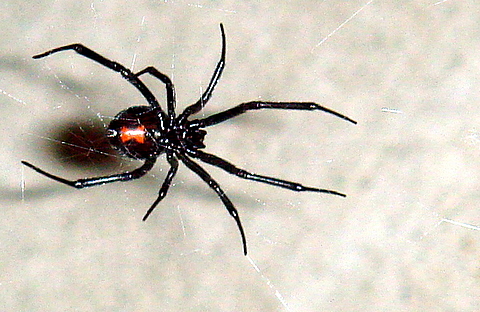Adult female black widow spiders are gloss black with an hourglass shaped marking on the underside of its abdomen which, although most commonly red, may range in color from white to yellow to various shades of orange and red. They also bear a small, usually red (colors vary) dot near the spinerettes, which is separate from the hourglass. In L. variolus, the two halves of the hourglass shape may be separated into two separate patches. A large female black widow spider can grow to about 1.5 inches (38 mm), counting legspan. The body is about 0.5-0.6 inches (12-16 mm). Male black widow spiders are half the size of the female or smaller. They have longer legs and a smaller abdomen in relation to their body size. They are also usually dark brown with varying colors of stripes/dots, with no hourglass mark. Adult males can be distinguished from juvenile females by their more-slender body, longer legs and large pedipalps typical of most other male spiders.
As with many venomous creatures, the brightly colored markings serve as a warning to predators. Eating a black widow will normally not kill a small predator (birds, et cetera), but the sickness that follows digestion is enough for the creature to remember that the bright red marking means "do not eat." Because the adult female black widow typically hangs and moves about its web upside down, its hourglass is on its front. However, juvenile widows (female) spend a large quantity of time in search of an optimal environment. Once an optimal location is found, adult female widows often spend their entire lives in one place. However, because juvenile females must first find this optimal location, they bear brightly colored marks upon their backs, so that they may be seen by predators when the widow is traveling upon its legs. Males bear similar marks to the females to serve as warning while they are searching for mates, however, the marks are not as prominent (not as brightly colored, or as large). Males, being less venomous, are less of a threat to predators, so having similar marks not as prominent helps predators to better judge their prey (some large birds can eat male widows without adverse effect, and so only avoid female widows. Those who cannot eat any widow without adverse effect eat nothing with the marks). Female juveniles develop an hourglass before the dorsal markings are shed. As is characteristic of all arthropods, black widow spiders have a hard exoskeleton composed of chitin and protein (5).
Prey
Black widow spiders typically prey on a variety of insects, but occasionally they do feed upon woodlice, diplopods, chilopods and other arachnids (McCorkle, 2002). When the prey is entangled by the web, L. mactans quickly comes out of its retreat, wraps the prey securely in its strong web, then punctures and poisons its prey (Foelix, 1982). The venom takes about ten minutes to take effect; in the mean time, the prey is held tightly by the spider (Foelix, 1982). When movements of the prey cease, digestive enzymes are released into the wound (Foelix, 1982). The black widow spider then carries its prey back to its retreat before feeding (Foelix, 1982).
Reproduction
See also: Sexual cannibalism
When a male is mature, he spins a sperm web, deposits semen on it, and charges his palpi with the sperm (3). Black widow spiders reproduce sexually when the male inserts his palpus into the female's spermathecal openings (3). The female deposits her eggs in a globular silken container in which they remain camouflaged and guarded (3). A female black widow spider can produce four to nine egg sacs in one summer, each containing about 100-400 eggs (1). Usually, eggs incubate for twenty to thirty days. Rarely do more than one hundred survive through this process, due to cannibalism. On average, thirty will survive through the first molting, due to cannibalism, lack of food, or lack of proper shelter. It takes two to four months for black widow spiders to mature enough to breed, however full maturation typically takes six to nine months. The females can live for up to five years, while a male's lifespan is much shorter. Very rarely after mating does the female eat the male. Usually if that happens it's because she mistakes him for the prey. Lifespans depend upon environment, with shelter being the greatest determining factor and food the second greatest.
Natural Enemies
There are various parasites and predators of widow spiders in North America, though apparently none of these have ever been evaluated in terms of augmentation programs for improved biocontrol. Parasites of the egg sacs include the flightless scelionid wasp Baeus latrodecti, and members of the chloropid fly genus Pseudogaurax. Predators of the adult spiders include a few wasps, most notably the blue mud dauber Chalybion californicum, and the spider wasp Tastiotenia festiva. Other species will occasionally and opportunistically take widows as prey, but the preceding all exhibit some significant specific preference for Latrodectus.
The Venom
[edit] Components and effects
Although their venom is extremely potent, (15 times as potent than that of the rattlesnakes; it is also reported to be much more potent than the venom of cobras and coral snakes), these spiders are not especially large. Compared to many other species of spiders, their chelicerae are not very large or powerful. In the case of a mature female, the hollow, needle shaped part of each chelicera, the part that penetrates the skin, is approximately 1.0 mm (around .04 inch) long, sufficiently long to inject the venom to a dangerous depth. The males, being much smaller, can inject far less venom and inject it far less deeply. The actual amount injected, even by a mature female, is very small in physical volume. When this small amount of venom is diffused throughout the body of a healthy, mature human, it usually does not amount to a fatal dose (though it can produce the very unpleasant symptoms of Latrodectism). Deaths in healthy adults from Latrodectus bites are relatively rare in terms of the number of bites per thousand people. Only 63 deaths were reported in the United States between 1950 and 1989 (Miller, 1992). On the other hand, the geographical range of the widow spiders is very great. As a result, far more people are exposed, world-wide, to widow bites than are exposed to bites of more dangerous spiders, so the highest number of deaths world-wide are caused by members of their genus. Widow spiders have more potent venom than most spiders, and prior to the development of antivenom, 5% of reported bites result in fatalities.
Improvements in plumbing have greatly reduced the incidence of bites and fatalities in areas where outdoor privies have been replaced by flush toilets. "Nearly ninety percent of the black widow bites reported in the medical literature of the first 4 decades of [the twentieth] century were inflicted on the male genitalia by spiders lurking underneath the seats of outdoor toilets." 1 In Sweden there have been incidents with black widow spiders being found in cars imported from southern USA. Old cars standing unused are an attractive habitat for the spider.


